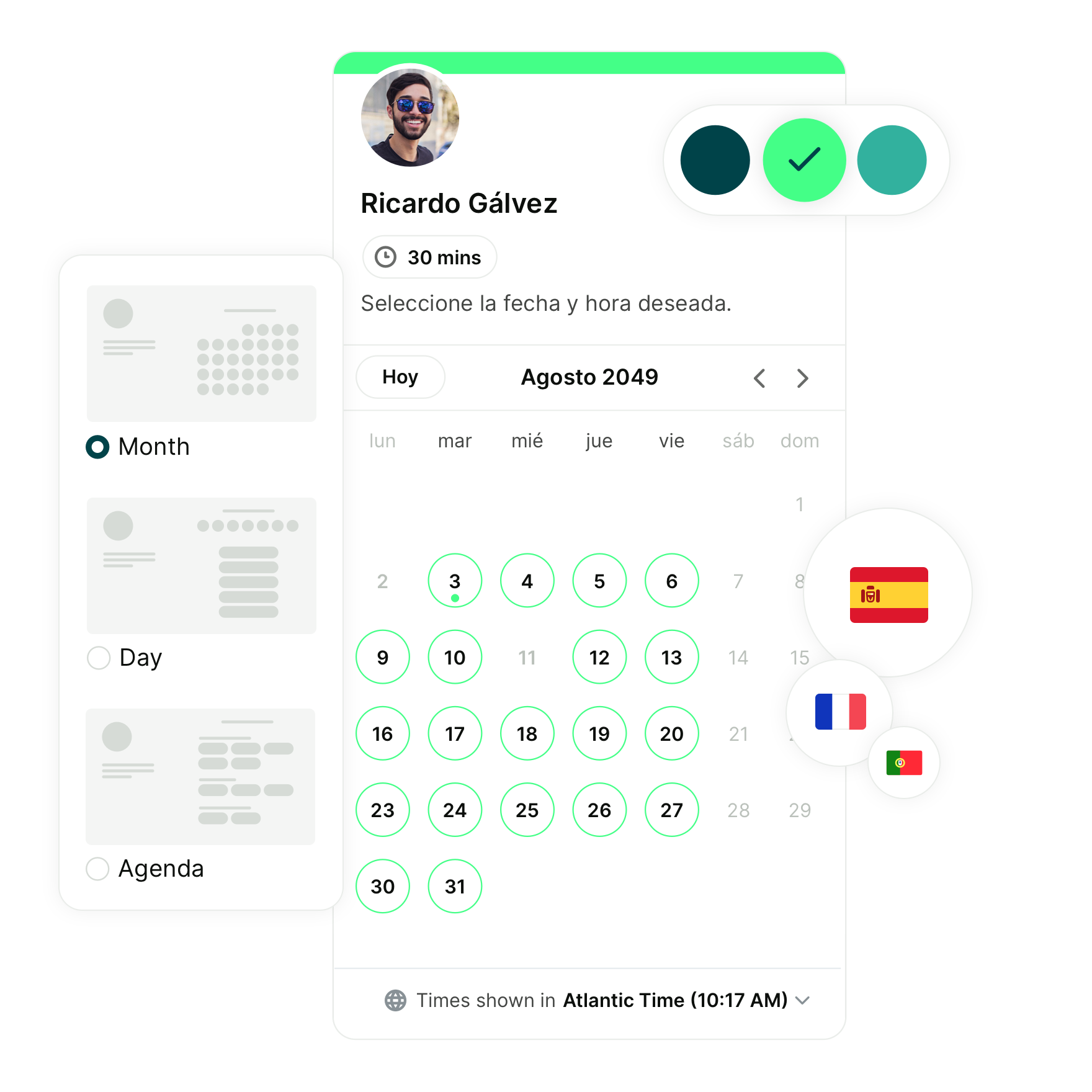6 Ways to Optimize Patient Scheduling for a Better Experience
Stop costly no-shows at your practice with a few simple scheduling tweaks. Learn the best strategies to keep patients happy and your clinic running smoothly.

Paulina Major

Ready to book more meetings?

Ever had one of those days where everything seems to go wrong with the schedule?
A double-booked appointment here, a no-show there, and before you know it, your waiting room is full, and you’re stretched thin. For small medical practices and private doctors, patient scheduling can be a constant source of frustration.
But here’s the good news: It doesn’t have to be this way.
With a few sure-fire strategies and the right patient scheduling software, you can make appointment booking run like clockwork.
Stick around, and we’ll show you how to do patient appointment scheduling the proper way so it’s no longer your main bottleneck.
First things first, why is patient scheduling important?
You know too well how frustrating it can be when a schedule gets out of hand.
It impacts the flow of your day.
It also impacts your patients.
When patients need to see a doctor, they don’t want to wait around for hours. Especially when they’re not feeling their best.
Imagine a patient trying to reach your practice. They call in and end up listening to music on hold for 20 minutes, anxiously waiting for someone to answer. Eventually, you pick up, and the call proceeds as expected.
But the frustration doesn’t end there. A few days later, something comes up, and the patient needs to reschedule their appointment. They call back, only to face the same 20-minute wait on hold, dealing with the same frustration all over again.
Things can go wrong in the waiting room, too. A patient arrives for their appointment, expecting to be seen on time, only to find out there’s a significant delay. The reason? Your schedule got messed up due to no-shows, overbookings, and unexpected walk-ins. As a result, your patient ends up waiting well past their original appointment time.
We can all agree—both situations are far from ideal!
With efficient scheduling, everybody wins. Your practice can plan and allocate the necessary resources for each appointment, and your patients get the best booking experience, with timely care and less hassle.
Here are some other advantages to keep in mind:
Benefits for patients |
Benefits for your practice |
|
Easier access to appointments |
Optimized appointment flow |
| More control over appointment times | Lower administrative burden |
| Automated appointment reminders and notifications for last-minute changes | Higher patient satisfaction |
| Better overall experience at the clinic | Lower costs due to fewer no-shows |
What are the five key steps to schedule a patient's appointment?
So, we’ve talked about why good scheduling matters—now let’s figure out how to do it right.
Your starting point is understanding the lifecycle of a patient’s scheduling experience. Fancy words, we know… But it’s just the steps your patients take to book an appointment with you.
Let’s break them down:
- Share your booking page: Make sure your patients can easily find your clinic’s booking page, whether through your website, email, or social media. Also, make it prominent because the easier it is to access, the more likely patients will schedule appointments without needing to call.
- Customize your intake form to collect the necessary information: Tailor your booking, or so-called intake form, to gather patient details upfront, such as contact information, reasons for the visit, and any special requirements.
- Send out booking confirmation with all of the details: Once an appointment is scheduled, send an immediate confirmation via email or text with all the details—date, time, location, and any preparation instructions.
- Set up appointment reminders: Implement appointment reminders and confirmation requests to go out a day or two before the appointment. Text or email reminders work well in this case.
- Offer an easy rescheduling option: Life happens, and sometimes patients need to change their appointments. Provide a simple way for them to reschedule online.

Best practices for efficient patient scheduling
Now that we’ve covered the basics, let’s explore a few best strategies that can help you make your patient scheduling even more efficient.
These tips will help you minimize no-shows, better manage your time, and keep your patients and you happy (and less stressed).
1. Allow patients to self-schedule
Letting patients book their own appointments online gives them control over their schedule and reduces your admin. You see, 73% of patients want to schedule their medical appointments online, so why force any other way?
Patients want flexibility so they can choose a time that works best for them. Plus, it has a bunch of benefits for you, such as reducing administrative burden and helping you fill empty slots.
2. Include your policies
It’s up to you to set and communicate your scheduling and cancellation policies to patients.
Don’t just assume patients will call to cancel—they might just skip the appointment, leaving you with a gap in your schedule and lost income. A single medical practice loses an average of $150,000 in revenue each year due to patient no-shows. That’s a lot!
To combat that, make sure your cancellation policy is front and center on your booking page. Highlight key details like the cancellation notice period (24 or 48 hours) and any last-minute fees for no-shows.
|
📚 Need a hand designing a cancellation policy that works? Read our comprehensive guide on how to develop an effective cancellation policy template. |
3. Maintain a waitlist
When patients cancel their appointments, they leave a sudden gap in your agenda. These gaps can be hard to fill and can seriously affect your bottom line.
Think about it…
If you’re a dental hygienist or a psychologist running your business solo, one or two cancellations can make a big dent in your revenue for a single day. What about over a year? Yeah, we’re talking thousands of dollars of lost income!
So how do you handle those empty slots?
A waitlist is your backup plan for when things don’t go as scheduled. Just pull someone from your waitlist to fill that slot. That’s time saved, money earned, and a happy patient who gets seen earlier than expected.
|
🌎 Real-world example: Carolina Traviglia, a dental hygienist from Switzerland, keeps her calendar booked up even when someone reschedules or cancels. |
4. Leave room for walk-ins and emergencies
It’s easy to think that filling your schedule to the brim is a good idea. However, it’s best to leave a few open slots each day for walk-ins or emergencies.
Emergencies don’t follow a schedule, and when they happen, patients will be grateful that you can see them right away.
Additionally, walk-ins can bring in new patients who might not be aware of your practice yet. Someone new to the area who doesn’t have a doctor might need quick care. If you help them when they need it, they may choose your clinic in the future.
From a planning perspective, these open slots can also help if earlier appointments overrun slightly. It sort of gives you some breathing space.
|
💡 Pro-tip: Your patients are your top priority, so try pairing your patient scheduling app with other tools, such as practice management software for ABA clinics, to streamline admin and ensure you can focus on delivering high-quality care. |
5. Set up an FAQ for patients
It’s always best to preempt any doubts or questions your patients might have to reduce potential calls for clarification or back-and-forth emails about appointment details.
The easiest way to do this? An FAQ section on your booking page that addresses common queries, such as:
- Office hours
- Cancellation policies
- What to bring to appointments
- How to reschedule
- How long the appointment will last
A well-placed FAQ section can prevent many unnecessary phone calls and help patients feel more informed and prepared before they even step through your door.
6. Accept deposits in advance
Not many doctors do this, but asking for a small deposit or credit card information can be an effective way to reduce no-shows and last-minute cancellations. This upfront commitment encourages patients to stick to their scheduled time. Plus, if they do need to cancel, they’re more likely to do so with enough notice.
It’s a simple tactic, but it can make a big difference in managing your medical schedule. Just make sure the process is easy and transparent so that patients understand the terms and feel comfortable with the arrangement.
Most specialized medical scheduling software (more on these tools in the next section) can process payments, so you don't need to lift a finger.
Leveraging technology for streamlined scheduling
Following our best tips for patient scheduling will give you a great start. But if you really want to level up, specialized scheduling software like YouCanBookMe can make all the difference.
The beauty of online scheduling tools is that they handle administrative tasks for you, allowing you to focus on what you do best: running your practice and caring for your patients.
Here are four reasons to say “Yes” to patient scheduling software:
- Automated appointment reminders: If no-shows are your biggest headache, medical scheduling tools have you covered with automated reminders via SMS or email. Patients receive a friendly nudge about their upcoming appointment, which they can confirm or reschedule with just a click.
- Online booking and self-scheduling: Specialized scheduling platforms allow patients to book, reschedule, or cancel appointments online, anytime, anywhere. Offering a self-service option frees up time for you or your admin staff, as it reduces the need to handle endless phone calls. It also provides patients with the flexibility to choose a time that suits them best.
- One-time booking links: Each patient receives a unique link to book an appointment, which can only be used once. This nifty feature prevents double bookings and keeps your schedule accurate—perfect for managing a high volume of appointments.
- Customizable intake forms: The best way to prepare for an appointment? Gather as much information as possible before seeing your patient. Most medical appointment booking solutions offer customizable intake forms, allowing you to request specific details based on the type of visit, such as medical history, insurance information, or the reason for the visit. No more scrambling for details or dealing with incomplete paperwork.
If you’re looking for a tool that checks all these boxes (and more, in fact), YouCanBookMe is worth checking out.
Our medical scheduling software brings everything together in one super-intuitive interface. It handles reminders and follow-ups for you, lets you offer different types of appointments, and even has dedicated pages for your staff so patients can pick the team member they want to see. You can literally customize your entire booking page! The best part? It’s really simple to use, so both you and your patients will love it.
With YouCanBookMe, you can focus on delivering excellent care, not juggling appointments.
The bottom line
Do you really want to be tied to the phone, trying to squeeze in appointments? Or is it time to bring some order to your patient scheduling?
It’s clear—offloading those constant calls and embracing a smarter scheduling system is the way forward. Follow our best practices and don’t shy away from trying an online scheduling tool like YouCanBookMe to streamline your process. Try it free today!
FAQ
What are the examples of patient scheduling?
Patient scheduling examples include annual check-ups, procedures, follow-ups, and open walk-in slots. You can also offer a variety of other options, like telemedicine appointments, lab tests, specialist referrals, same-day slots, and recurring appointments for chronic conditions.
What does it mean to schedule a patient?
Scheduling a patient involves coordinating a time that works for both the patient and their healthcare provider to hold an appointment and deliver the necessary medical services or care based on the patient's needs.
How to schedule patient appointments?
There are several ways to schedule patient appointments. The most effective method is to use a patient scheduling app, which offers 24/7 access, real-time availability, and automated reminders, making the process more convenient and efficient for both patients and healthcare professionals. Phone scheduling is another option. It provides a personal touch but can be time-consuming and lacks the convenience of online scheduling tools.
Subscribe to our newsletter
Get productivity tips, news, articles and resources.
Written by
Paulina Major
Paulina grew up wanting to be a commercial pilot, but life steered her toward content writing. With a passion for tech and business, she’s found her calling in helping brands share their stories every day. Her non-negotiable? Morning coffee—because nothing starts without that first sip.







